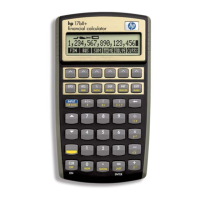Getting Started 9
open a menu or menu item, press the
A key that corresponds to the
desired label. The menu structure is hierarchical, so at any time, pressing
G
returns you to the previously displayed menu. Some key points about menus:
•Press
gb at any time to return to the MAIN menu. The MAIN
menu includes options for: finance (FIN), business percentages (BUS),
statistics (SUM), time manager (TIME), Equation Solver (SOLVE), and
currency exchange (CURRX). Use Table 1-3 below as a quick
reference. For a complete list of menu labels and their corresponding
operations, as well as chapter references, see page 24.
• For help navigating through menus with menu maps, refer to pages 25
and 254-260.
• After pressing a menu key, the message, SELECT A MENU, appears
when a sub menu is available.
• When a menu has more than six labels, MORE appears as an option.
Select MORE to switch between sets of labels within the same menu
level.
• To store a value for a variable, key in the number and press the menu
key that corresponds to your choice. To calculate an unknown value for
a variable, enter all known values for related variables, then press the
menu key that corresponds to the unknown variable (pages 25-28).
• Pressing clear data,
gc, clears all data in the currently
displayed menu and returns the value of any of the menu’s variables to
zero (page 28).
Storage Registers and Continuous Memory
Numbers (data) are stored in memories called “registers.” Special registers
are used for storing numbers during calculations. These are the “stack” regis-
ters, and the “Last X” register, which is used for storing the last number in the
display before operations are performed in RPN mode. Numbers are stored
automatically in these registers. There are also ten registers in which you can
manually store data, numbered 0-9. All these storage registers make up the
calculator’s Continuous Memory. All information in the Continuous Memory
is preserved even while the calculator is turned off. To monitor the amount of

